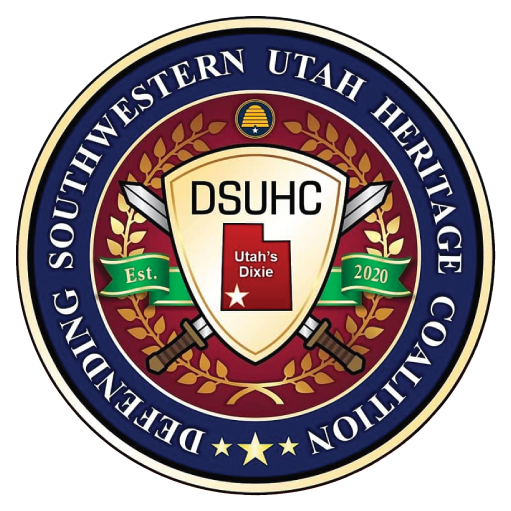SPECIAL MESSAGE FROM PRESIDENT DOUG ALDER
I am Douglas D. Alder, a Guest Spokesperson for DSUHC. I served as President of Dixie College from 1986 to 1993 and am very much in favor of preserving the name.
THE WORD “DIXIE”
When I became president of Dixie College in 1986 we were known as the “Rebels.”
Over the years the names have changed. In 1911 it was called St. George Stake Academy. In 1916 two years of teacher preparation made it a two-year college and gave it the name of Dixie Junior College. In the October 1999 Board of Regents meeting they voted to change the mission of Dixie College to that of a four-year state college during President Robert Huddleston’s administration. In July 2000 a four-year CIT degree was offered. The “Rebels” mascot changed to “Red Storm” and now the Dixie State University students are called “Trailblazers.” At the present time Master’s degrees are now offered in three departments, with several others in preparation.
The early settlers of this area adopted the name “Dixie” because they came from the north (northern Utah) to the south (southern Utah) to grow a crop that is also grown in the southern states of the United States –cotton. With the “Dixie” name, and over time, came other additions from the south, such as the name “Rebels” and use of the Confederate flag. While the flag, year book name, statue of a Rebel soldier lifting an injured Union soldier, and other references are gone from campus, questions have remained about whether leaders in higher education should eliminate the
name “Dixie” to once and for all end the discussion of the university’s linkage with the south.
When Dr. Stephen Nadauld became president of the college, he immediately faced a major political issue. Prior to his arrival, the University of Utah had offered to adopt Dixie into the University of Utah. Many Dixie faculty members were supportive. It would mean more resources, stature and success. Utah State University was in the process of incorpora-
ting the College of Eastern Utah (Price) into its system which already included USU operations in Brigham City, Vernal, Roosevelt, Tooele, Moab, Blanding and other locations. Dixie faculty
members could see the opportunity to offer U. of U. courses without waiting years for Dixie to be recognized nationally as ready to teach such courses.
On one of his first days in office, President Nadauld held a meeting for all faculty and staff. Someone asked: “Are we about to become part of the University of Utah?” The issue
was delicate because the University of Utah had made a statement that it would accept Dixie if it would drop the “Dixie” name and change its identity to the “University of Utah, St. George.” President Nadauld pondered the question briefly and then responded with precision:
“We shall become a university.”
He then went to work by hiring a survey company that had interviewers question hundreds of students, faculty and administrators as well as numerous residents in the community and business and political leaders. At the conclusion of their surveys and
interviews they reported that 73 percent of those surveyed favored keeping “Dixie” in the name of the university. Thus, today we have Dixie State University as the name of the school.
Why such loyalty to a name? Many of those surveyed and interviewed were among those who had helped build the institution over many decades. Others were descendants of early pioneers who had labored and toiled to make this region successful. Dixie College,
and DSC and DSU thereafter, was a central focus for the community’s efforts, their hopes and dreams. Without these volunteers and dedicated patrons, and those before them, DSU would not be what it is today.
These people are those who could tell you the story of southern Utah’s hard-working culture, despite the odds against them. They could tell about the early generations who “came
to Dixie” at great sacrifice, to a place that was hot and sweltering, where cotton was raised, milled, made into cloth and then sold in the north. They could tell you how community
members founded and kept Dixie College alive when other funding ceased, and that the school would survive in one building, with few faculty, and only promises of future payment because funding sources had dried up in the Great Depression.
They could tell you also about how the school caught breaks, rode enrollment waves, and expanded, eventually carrying growth to a substantial new campus environment, and
then how it developed year by year, from a small, two-year community college to a four-year college, and now a state university with graduate offerings. They could tell of funds sought and raised by local residents to make such growth possible. In all of these conversations, people would exhibit pride and accomplishment. They were part of something greater than themselves.
They have been the teachers, the recruits, the students, the staff, and leaders who participated in the growth and development of the institution. They have cheered for the
Dixie’s teams, year after year. They would describe what the name Dixie means to them. It means much more than an historical reference to another southern region where cotton
grows. Dixie has come to mean something of its own to residents of southwestern Utah. The name Utah’s “Dixie” is legacy now, essentially unique from any other U.S. story that might
be told or associated by it.
If you were to ask a person on the street if Dixie State University has anything to do with the Civil War or slavery in the South, you might get a blank stare from that person. When that war began, Brigham Young sent a message to Abraham Lincoln stating: “We
are with you. We are on the side of the North.”
— Douglas D. Alder
President Emeritus
Dixie College, 1986-1993
History of Dixie State College by Douglas D. Alder, 2010.

